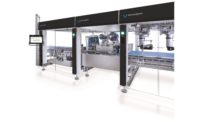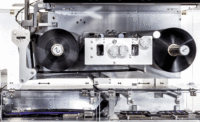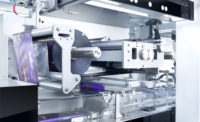Company: Gerhard Schubert GmbH
Website: www.schubert.group/en/
Equipment Snapshot: In order to be able to use the heat-sealing film even more flexibly when packaging in flowpacks, Schubert has developed a new heat-sealing robot for its Flowmodul. For the first time ever, the flow-wrapper’s new cross-sealing unit allows constant sealing times with variable chain speed and a wide control range of the film. Confectionery manufacturers can now gently package a large range of products in flowpacks with the cost-efficient heat-sealing film. This also includes highly sensitive products such as chocolate.
Compared to cold-sealing, the packaging of products in flowpacks with heat-sealing technology offers various advantages. The heat-sealing film is inexpensive, can be stored for a long time and leaves no adhesive residue when the packaging is opened. To ensure a high-quality seal, three factors—temperature, pressure and time—must remain constant during the sealing process. Additionally, not every product can withstand the heat. And until now, this has limited flexibility in the packaging process.
The Crailsheim-based packaging machine manufacturer’s patented sealing technology enables customers to use the heat-sealing film for an even wider range of products. Schubert developed the Flowmodul’s two sealing units specifically to achieve this. First, the flowpack’s longitudinal sealing unit is equipped with ultrasonic technology. The heat is generated directly in the heat-sealing film and is not distributed as usual onto the tools and machine parts. Therefore, heat-sensitive products such as chocolate also remain flawless during longitudinal sealing. Furthermore, ultrasonic technology ensures consistent seal quality at different speeds. Secondly, instead of a conventional fixed cross-sealing unit, the new heat-sealing robot is used in the flow-wrapping unit. “The use of constant sealing times at variable chain speeds is the key to our newly developed flying cross-sealing unit. And with it, we are opening up new dimensions in the control range of the heat-sealing film,” explains Johannes Schubert.
The moving component breaks the rigid mechanical connection between the chain and the cross-sealing process: when the chain’s speed changes, the sealing unit moves either with or against the direction of product flow. The duration of the sealing time is therefore independent of the feed rate and can be programmed to milliseconds. The new cross-sealing unit adapts to the variable speed of the upstream pick & place robots for each individual flowpack, therefore guaranteeing consistent sealing times. Like all sealing technologies from Schubert, the flying cross-sealing unit can be integrated into any Flowmodul and combined with other sealing techniques.
By switching from cold- to hot-sealing technology, it is possible to save up to 17 per cent in film material costs. Many different products including biscuits, chocolate, marzipan, pancakes and French toast, as well as BFS products from the pharmaceutical sector, are already being packed with the combination of a flying cross-sealing unit and an ultrasonic longitudinal sealing unit from Schubert.




